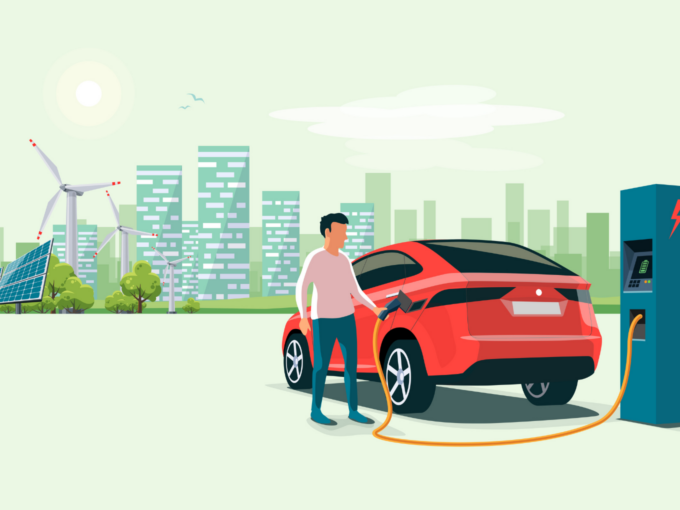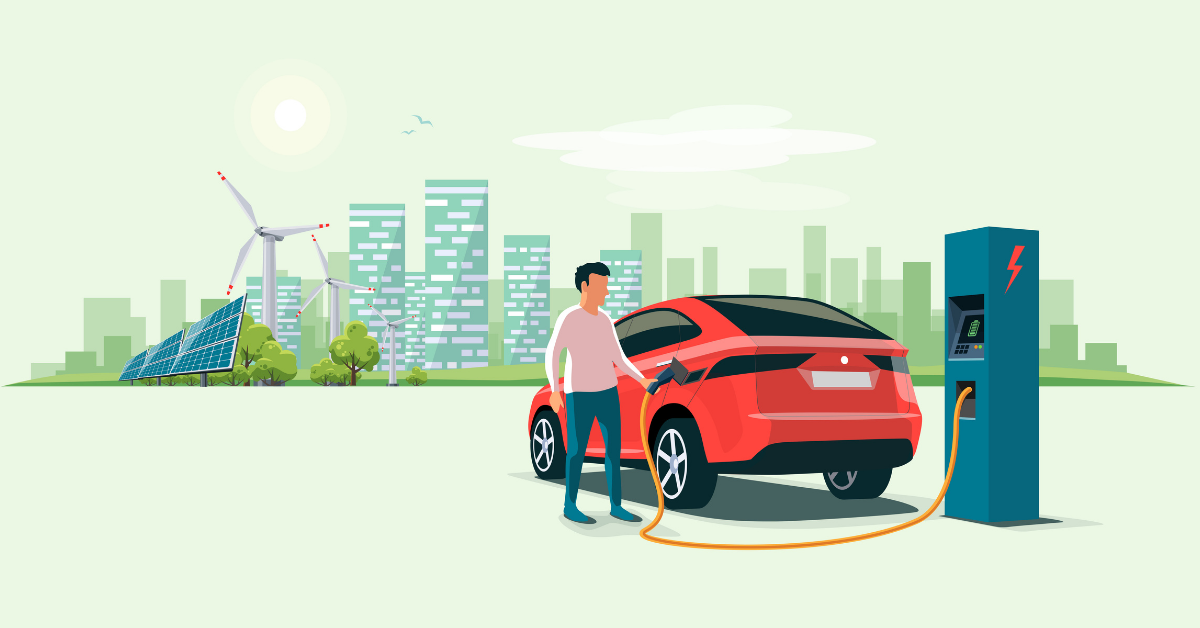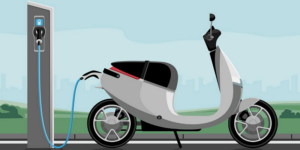India’s electric vehicle market size is expected to reach $152.2 Bn by 2030
The adoption rate of EVs in India is moving sluggishly primarily because the EVs are not priced at par with ICE vehicles and come at a premium
Formulation and rollout of more stringent statutes aimed at the adoption of EVs will give a big push to electric mobility

The electric vehicle (EV) industry has seen a drastic change over the last decade. India, however, lags considerably in terms of EV penetration, compared to other larger markets. EV penetration in India stands at 0.8%. Though, there is a huge scope to work on when it comes to the number of models, charging infrastructure, developing vendor ecosystem and providing financial incentives. Globally speaking, India is the largest 2W and 3W market. It is also amongst the top five in the commercial vehicles (CV) segment.
Electric Vehicles are the latest automotive trend right now. India’s electric vehicle market size is expected to reach $152.21 Bn by 2030. The market is expected to expand at a CAGR of 94.4% from 2021 to 2030.
EV technology is attracting eyeballs worldwide. It promises a reduction in fossil fuel dependency and a chance to achieve the global goal of zero-carbon emission and sustainable development.
At the recently concluded COP26, India has pledged to reduce its carbon emissions to net-zero by the year 2070. India has set a goal to achieve EV sales accounting for 30% of private cars, 70% of commercial vehicles, and 80% of two and three-wheelers by the year 2030. In a country that is still heavily dependent on coal, stringent steps have to be taken to achieve these ambitious targets.
According to recent research by Accelerated e-Mobility Revolution for India’s Transportation (e-amrit) portal in India, only 7,96,000 Electric vehicles have been registered till December 2021, and only 1,800 charging stations have been installed in public places. The country has a long way to go to achieve the recommended ratio.
EV sales have seen a growth of 133% from FY 2015 to FY 2020. When compared to sales of conventional ICE vehicles, it seems insignificant.
The adoption rate of EVs in India is moving sluggishly primarily because the EVs are not priced at par with ICE vehicles and come at a premium. It impacts the purchase decision of buyers, more so in the lower-end car segment.
The rising cost of batteries leads to the high price of EVs. These batteries are being imported from countries such as China, Japan, and Australia with the import-cost tag, which makes EVs unaffordable as compared to their ICE counterparts.
Next Steps For The EV Industry
The government needs to focus on building a supply chain by manufacturing batteries domestically. India should focus more on attracting foreign battery manufacturers as well as domestic players to set up local production facilities. It will help to lower the cost of batteries and EVs, improving the cost competitiveness.
Some Indian state-run companies endeavour to purchase and hold mining assets overseas. Mines of minerals such as lithium and cobalt are used for manufacturing batteries for EVs. A few months back, many lead-acid battery manufacturers set up a technology hub in Andhra Pradesh to develop lithium-ion cells with a plan to start manufacturing lithium-ion batteries locally.
With the roll-out of FAME II, the Department of Heavy Industries allocated INR 1000 Cr for setting up electric vehicle charging infrastructure in India. The Ministry of Power clarified that setting up public EV charging stations does not need a license under the Electricity Act, 2003 to transmit, distribute or trade. EVCIs are to be set up for promoting Charging Infrastructure for Electric Vehicles.
The government should make private charging at residences or offices permissible. A public EV charging station will be given an electricity connection on a priority basis by the concerned power distribution company (DISCOM). The public EV charging station can now obtain electricity from any generation company through open access channels. This will help the EV users who face difficulty in finding EVCIs during long-distance travel which will result in EVCIs establishment and boost EV sales.
We should be more focused on incentivizing the investors to set up EVCI by providing differential tariff rates in the country. The Delhi Government has, through its EV policy, stipulated to maintain a special tariff rate for EV charging. Under this policy, they will follow business models to set up public EV charging stations, either directly, or indirectly under a license, franchise or public-private partnership model.
Recently, the Government of Karnataka, involved a Special Purpose Vehicles (SPV) set up to foster the installation of EVCIs in Bengaluru. These models should include private sector involvement by way of public-private partnership. This will help in the procurement of land and electricity supply while the private entity could provide for the necessary infrastructure and tech-driven data.
To streamline the process of procuring environmental, labour, electrical, and other clearances through a combined application, States should facilitate the creation of a ‘Single-Window’ which would act as a one pit-stop. It helps to provide aid in reducing the time taken to process applications for the installation and operation of EVCIs on a state level.
Many state governments provide concessions and exemptions on the supply end, like capital investment subsidies. One of the capital subsidies provided by Andhra Pradesh is a subsidy of 25% of the charging infrastructure or equipment cost for the first 100 private charging stations, with the maximum subsidy of INR 10 Lakhs. It can be enhanced in terms of value and time.
The scope of India’s EV market growth depends on the availability of capital for original equipment manufacturers, manufacturers of batteries as well as improvements in the infrastructure and diversified options for consumers. Adoption of electric vehicles in India will also require an estimated annual battery capacity of 158 GWh by FY 2030, which provides huge investment opportunities. To support the growth of EVs in India, apart from the demand incentives offered to buyers and to reduce the cost of EVs and batteries, we need to create awareness among people about the benefits of EVs over ICE vehicles.
In the recently announced budget, the government has taken many initiatives such as the battery swapping policy which will benefit electric commercial vehicle makers and auto component players considerably. The government’s announcement to invest in new infrastructure projects and the focus on the rural economy will also have a vital impact on the automotive sector. Though the impact might not be enough to change the overall business sentiment.
The new policy on battery swapping will help in the wide-scale adoption of batteries as a service. It will help to reduce upfront ownership costs of electric vehicles and link that cost to vehicle running. As the cost of running electric vehicles is cheaper, the running cost with battery service will be more economical than the usage of ICE based vehicles.
It will help to create opportunities for several new startups operating in the EV infrastructure space such as Battery Smart, RACEnergy, Lohum cleantech. In cities, zero-emission zones will help bring prominence to electric vehicles and provide an incentive to purchase electric vehicles.
The government has been rolling out Production-Linked Incentive (PLI) schemes to boost market demand in priority segments like electric two-wheelers, and localizing production of key components like ACC battery storage.
Several Indian states have also passed EV policies intending to attract industry investments and make EV adoption a more viable proposition for the consumer market. India is promoting renewable energy capacity globally. This huge shift will lead to greater incentivisation of EV producers and users. Additionally, formulation and rollout of more stringent statutes aimed at the adoption of EVs will also give a big push to electric mobility.








